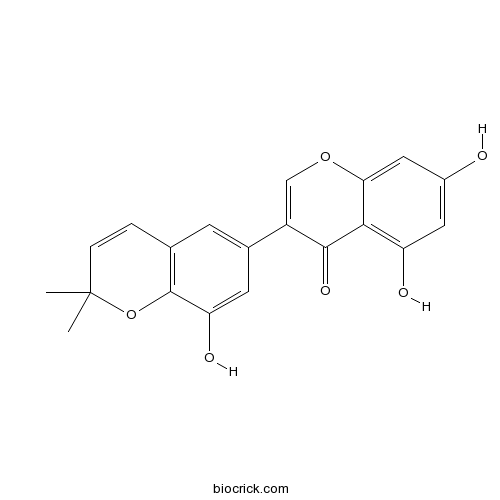Semilicoisoflavone BCAS# 129280-33-7 |

Quality Control & MSDS
3D structure
Package In Stock
Number of papers citing our products

| Cas No. | 129280-33-7 | SDF | Download SDF |
| PubChem ID | 5481948 | Appearance | Powder |
| Formula | C20H16O6 | M.Wt | 352.3 |
| Type of Compound | Flavonoids | Storage | Desiccate at -20°C |
| Solubility | Soluble in Chloroform,Dichloromethane,Ethyl Acetate,DMSO,Acetone,etc. | ||
| Chemical Name | 5,7-dihydroxy-3-(8-hydroxy-2,2-dimethylchromen-6-yl)chromen-4-one | ||
| SMILES | CC1(C=CC2=C(O1)C(=CC(=C2)C3=COC4=CC(=CC(=C4C3=O)O)O)O)C | ||
| Standard InChIKey | LWZACZCRAUQSLH-UHFFFAOYSA-N | ||
| Standard InChI | InChI=1S/C20H16O6/c1-20(2)4-3-10-5-11(6-15(23)19(10)26-20)13-9-25-16-8-12(21)7-14(22)17(16)18(13)24/h3-9,21-23H,1-2H3 | ||
| General tips | For obtaining a higher solubility , please warm the tube at 37 ℃ and shake it in the ultrasonic bath for a while.Stock solution can be stored below -20℃ for several months. We recommend that you prepare and use the solution on the same day. However, if the test schedule requires, the stock solutions can be prepared in advance, and the stock solution must be sealed and stored below -20℃. In general, the stock solution can be kept for several months. Before use, we recommend that you leave the vial at room temperature for at least an hour before opening it. |
||
| About Packaging | 1. The packaging of the product may be reversed during transportation, cause the high purity compounds to adhere to the neck or cap of the vial.Take the vail out of its packaging and shake gently until the compounds fall to the bottom of the vial. 2. For liquid products, please centrifuge at 500xg to gather the liquid to the bottom of the vial. 3. Try to avoid loss or contamination during the experiment. |
||
| Shipping Condition | Packaging according to customer requirements(5mg, 10mg, 20mg and more). Ship via FedEx, DHL, UPS, EMS or other couriers with RT, or blue ice upon request. | ||
| Description | 1. Semilicoisoflavone B can inhibit sorbitol formation of rat lens incubated with a high concentration of glucose, indicates that it may be effective for preventing osmotic stress in hyperglycemia. |

Semilicoisoflavone B Dilution Calculator

Semilicoisoflavone B Molarity Calculator
| 1 mg | 5 mg | 10 mg | 20 mg | 25 mg | |
| 1 mM | 2.8385 mL | 14.1924 mL | 28.3849 mL | 56.7698 mL | 70.9622 mL |
| 5 mM | 0.5677 mL | 2.8385 mL | 5.677 mL | 11.354 mL | 14.1924 mL |
| 10 mM | 0.2838 mL | 1.4192 mL | 2.8385 mL | 5.677 mL | 7.0962 mL |
| 50 mM | 0.0568 mL | 0.2838 mL | 0.5677 mL | 1.1354 mL | 1.4192 mL |
| 100 mM | 0.0284 mL | 0.1419 mL | 0.2838 mL | 0.5677 mL | 0.7096 mL |
| * Note: If you are in the process of experiment, it's necessary to make the dilution ratios of the samples. The dilution data above is only for reference. Normally, it's can get a better solubility within lower of Concentrations. | |||||

Calcutta University

University of Minnesota

University of Maryland School of Medicine

University of Illinois at Chicago

The Ohio State University

University of Zurich

Harvard University

Colorado State University

Auburn University

Yale University

Worcester Polytechnic Institute

Washington State University

Stanford University

University of Leipzig

Universidade da Beira Interior

The Institute of Cancer Research

Heidelberg University

University of Amsterdam

University of Auckland

TsingHua University

The University of Michigan

Miami University

DRURY University

Jilin University

Fudan University

Wuhan University

Sun Yat-sen University

Universite de Paris

Deemed University

Auckland University

The University of Tokyo

Korea University
- PF-2545920
Catalog No.:BCC2279
CAS No.:1292799-56-4
- Boscialin
Catalog No.:BCN7323
CAS No.:129277-03-8
- Pierreione B
Catalog No.:BCN6855
CAS No.:1292766-21-2
- Perospirone hydrochloride
Catalog No.:BCC9118
CAS No.:129273-38-7
- Hoechst 33258 analog 6
Catalog No.:BCC1628
CAS No.:129244-66-2
- IKKε-IN-1
Catalog No.:BCC5514
CAS No.:1292310-49-6
- 15-Dihydroepioxylubimin
Catalog No.:BCN4800
CAS No.:129214-59-1
- (2S,3S)-(-)-Glucodistylin
Catalog No.:BCN6156
CAS No.:129212-92-6
- Iberiotoxin
Catalog No.:BCC6932
CAS No.:129203-60-7
- Biotin-HPDP
Catalog No.:BCC3583
CAS No.:129179-83-5
- Gancaonin M
Catalog No.:BCN4757
CAS No.:129145-51-3
- 2-(2,2-Dimethyl-1,3-dioxolan-4-yl)propane-1,2-diol
Catalog No.:BCC8475
CAS No.:129141-48-6
- Isoangustone A
Catalog No.:BCN6819
CAS No.:129280-34-8
- Licorisoflavan A
Catalog No.:BCN6662
CAS No.:129314-37-0
- Alendronate sodium
Catalog No.:BCC3719
CAS No.:129318-43-0
- O-Geranylconiferyl alcohol
Catalog No.:BCN4747
CAS No.:129350-09-0
- 11-Chloro-2,3,3a,12b-tetrahydro-2-methyl-1H-dibenz[2,3:6,7]oxepino[4,5-c]pyrrol-1-one
Catalog No.:BCC8430
CAS No.:129385-59-7
- Physcion 8-O-rutinoside
Catalog No.:BCN7324
CAS No.:129393-21-1
- Euphorbia factor L9
Catalog No.:BCN3786
CAS No.:129393-28-8
- Fmoc-Phenylalaninol
Catalog No.:BCC2717
CAS No.:129397-83-7
- Boc-Cysteinol(pMeBzl)
Catalog No.:BCC3044
CAS No.:129397-85-9
- Fulvestrant
Catalog No.:BCC1081
CAS No.:129453-61-8
- Fmoc-Asp-OtBu
Catalog No.:BCC3088
CAS No.:129460-09-9
- 3,4-Diacetoxycinnamamide
Catalog No.:BCN6157
CAS No.:129488-34-2
Aldose reductase inhibitory compounds from Glycyrrhiza uralensis.[Pubmed:20460778]
Biol Pharm Bull. 2010;33(5):917-21.
We evaluated the inhibitory effects of components from the root of Glycyrrhiza uralensis (G. uralensis) on aldose reductase (AR) and sorbitol formation in rat lenses with high levels of glucose as part of our ongoing search of natural sources for therapeutic and preventive agents for diabetic complications. In order to identify the bioactive components of G. uralensis, 5 prenylated flavonoids (Semilicoisoflavone B, 7-O-methylluteone, dehydroglyasperin C, dehydroglyasperin D, and isoangustone A), three flavonoids (liquiritigenin, isoliquiritigenin, and licochalcone A), and two triterpenoids (glycyrrhizin and glycyrrhetinic acid) were isolated; their chemical structures were then elucidated on the basis of spectroscopic evidence and comparison with published data. The anti-diabetic complication activities of 10 G. uralensis-derived components were investigated via inhibitory assays using rat lens AR (rAR) and human recombinant AR (rhAR). From the 10 isolated compounds, Semilicoisoflavone B showed the most potent inhibition, with the IC(50) values of rAR and rhAR at 1.8 and 10.6microM, respectively. In the kinetic analyses using Lineweaver.Burk plots of 1/velocity and 1/concentration of substrate, Semilicoisoflavone B showed noncompetitive inhibition against rhAR. The results clearly indicated that the presence of a gamma,gamma-dimethylchromene ring is partly responsible for the AR inhibitory activity of isoprenoid-type flavonoids. Further, Semilicoisoflavone B inhibited sorbitol formation of rat lens incubated with a high concentration of glucose, indicating that this compound may be effective for preventing osmotic stress in hyperglycemia.


